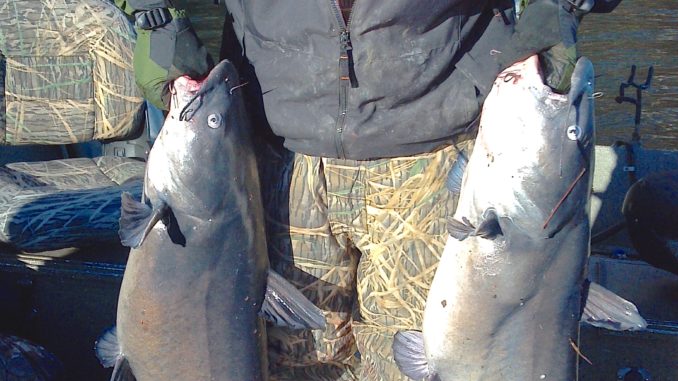
Looking for fishing guide Robbie Burr in December? You’ll probably find him anchored near North Carolnia’s Blewett Falls Lake’s “logjam” — trying to catch huge blue catfish.
“The logjam is a well-known catfish hot spot at Blewett Falls,” said Burr, who runs Pee Dee Fishing Adventures (www.pdfishingadventures.com). “It’s an extended point in front of the dam that’s marked with a buoy where driftwood, trees and logs collect. Shad stack up around the wood, and so do big blue catfish.”
The water is 20 to 30 feet deep. To fish the area, Burr either ties on to a piece of wood or drops anchor. He sets out six to eight rods spider-rigged around his boat.
“If there’s a strong current, I’ll use six rods to keep the rigs under control,” he said.
This time of year, he uses cut gizzard shad exclusively because live bait dies too quickly. He favors 7-foot, medium-action Shakespeare Tiger Ugly Stiks in conjunction with ABU 7000 reels.
“I like medium-action rods with braided line,” Burr said. “The braid has no give, so the rods have to have some give when one of those monster cats takes the bait, or something is going to break.”
Burr uses 100-pound test Power Pro braided line on his reels and ties it to a barrel swivel with a Palomar knot, which begins a Carolina rig featuring a 13- to 14-inch leader of 80-pound monofilament connected to the other end of the barrel swivel with a Palomar knot.
Before the main line is connected to the swivel, Burr slides on a 1- or 2-ounce flat, no-snag weight. The rig is completed with a No. 8/0 snelled circle hook. Burr makes the snelled portion himself.
Burr checks his electronics to see if the shad are indeed stacked up at the logjam. Whether he’s fishing the logjam or elsewhere, if he doesn’t see large pods of shad on his depth finder’s screen, he’ll give the spot about 30 minutes and leave if the bites are scarce.
Burr said another winter hot spot is the Grassy Island area at the upper end of the lake where shad also occasionally stack up in 20 to 25 feet of water.
Burr said he rarely drifts but prefers to anchor and lower his baits vertically at various depths in the water column, using his electronics as a guide as to which depths are likely to be the most productive.
Burr said the action picks up for blue cats from 15 to 40 pounds — and occasionally larger — when the water temperature dips below 60 degrees.




Be the first to comment